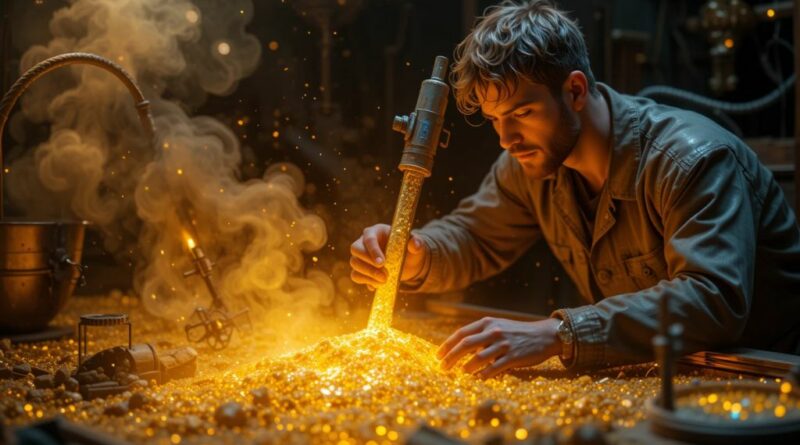The Carbon Revolution: Turning CO₂ Into Industrial Gold
A groundbreaking catalyst developed at EPFL could transform how industries handle carbon dioxide, turning waste into wealth with unprecedented efficiency.
In the fight against climate change, carbon dioxide has long been cast as the villain—a greenhouse gas to be captured, stored, or eliminated at all costs. But what if we’ve been thinking about CO₂ all wrong? What if, instead of simply trying to banish this ubiquitous molecule, we could transform it into something valuable?
In laboratories around the world, scientists are pioneering electrochemical CO₂ conversion—a revolutionary process that could fundamentally reshape how industries approach carbon management. The latest breakthrough comes from Switzerland, where researchers at École Polytechnique Fédérale de Lausanne (EPFL) have developed a catalyst so efficient and durable that it could finally make large-scale carbon recycling economically viable.
The Promise and the Problem
The concept of converting CO₂ into useful chemicals isn’t new. For decades, scientists have understood that with the right catalyst and sufficient energy, carbon dioxide can be transformed into everything from carbon monoxide and methanol to more complex hydrocarbons. The appeal is obvious: instead of treating CO₂ as waste, industries could recycle it into valuable feedstocks for manufacturing, creating a circular carbon economy.
But the devil, as always, is in the details. Traditional electrochemical CO₂ conversion faces a fundamental challenge that has kept it confined to research laboratories rather than industrial facilities. Most existing catalysts operate at relatively low temperatures and suffer from what chemists call the “durability-efficiency dilemma.”
At lower temperatures, around 200-400°C, many catalysts can achieve reasonable efficiency but typically degrade within 100 hours of operation. Their energy efficiency rarely exceeds 35%, meaning that more than half the electrical input is wasted as heat rather than converted into useful chemical bonds. For industrial applications requiring continuous operation over months or years, this simply isn’t practical.
Higher temperatures, between 600-1,000°C, can dramatically improve reaction rates and efficiency. However, most catalysts either break down under these harsh conditions or require precious metals like platinum or palladium, making them prohibitively expensive for large-scale deployment.
This is where Professor Xile Hu and his team at EPFL enter the story with a solution that could change everything.
A Catalyst Revolution
The EPFL breakthrough centres on an ingenious approach to catalyst design that addresses both durability and efficiency simultaneously. Working with postdoctoral researcher Wenchao Ma, Hu’s team developed a cobalt-nickel alloy catalyst that’s encapsulated within a ceramic shell made from Sm₂O₃-doped CeO₂ (SDC).
The encapsulation is key. One of the main reasons high-temperature catalysts fail is metal agglomeration—tiny metal particles clump together over time, reducing the surface area available for chemical reactions. It’s like having a sponge that gradually loses its pores. The ceramic shell prevents this clustering, maintaining the catalyst’s active surface area even after thousands of hours of operation.
Using a sol-gel synthesis method, the researchers mixed metal salts with organic molecules to create nanoscale metal clusters, then encased them in ceramic shells. After testing various metal combinations, they discovered that a balanced mixture of cobalt and nickel delivered optimal performance—cobalt providing activity for CO₂ conversion while nickel enhanced selectivity and stability.
The results were nothing short of remarkable. Operating at 800°C, the catalyst achieved 90% energy efficiency while converting CO₂ to carbon monoxide with 100% selectivity. In practical terms, this means nearly every electron flowing through the system contributed directly to the desired chemical reaction, with virtually no wasteful side reactions producing unwanted byproducts.
Perhaps most impressively, the catalyst maintained this performance for over 2,000 hours of continuous operation—a twenty-fold improvement over typical low-temperature systems and far exceeding what most high-temperature catalysts can achieve.
Industrial Game-Changer
The implications extend far beyond laboratory benchmarks. Carbon monoxide is a crucial industrial chemical, serving as a key component in the production of methanol, synthetic fuels, and various plastics and chemicals through processes like the Fischer-Tropsch synthesis. Currently, most industrial CO is produced from fossil fuels through steam reforming of natural gas or coal gasification.
If CO₂ conversion technology could be deployed at industrial scale, it would create a paradigm shift. Instead of extracting carbon from fossil fuels, industries could source it directly from captured CO₂ emissions or even atmospheric CO₂. Steel plants, cement factories, and chemical manufacturers—some of the world’s largest CO₂ emitters—could potentially become carbon recyclers rather than just carbon producers.
The economic implications are equally compelling. The EPFL team estimates their catalyst could reduce overall production costs by 60-80% compared to existing CO₂ conversion technologies. This cost reduction stems not just from improved efficiency but also from the catalyst’s exceptional durability, which dramatically reduces replacement and maintenance costs.
The Broader Carbon Conversion Landscape
The EPFL breakthrough is part of a broader renaissance in carbon utilisation research. Companies like Climeworks are already operating large-scale direct air capture facilities, while firms such as Carbon Engineering and Global Thermostat are developing technologies to extract CO₂ directly from ambient air.
Meanwhile, other research groups are exploring different approaches to CO₂ conversion. Some focus on producing methanol or higher-value chemicals like ethylene. Others investigate biological conversion using engineered microorganisms. The diversity of approaches reflects both the complexity of the challenge and the enormous potential rewards.
What sets the EPFL catalyst apart is its combination of practical operating conditions, exceptional durability, and use of relatively abundant materials. Cobalt and nickel, while not as common as iron or aluminium, are far more abundant and affordable than precious metals. The ceramic support materials are also relatively inexpensive and well-understood in industrial applications.
Challenges and Opportunities
Despite its promise, significant challenges remain before this technology reaches commercial deployment. Scaling from laboratory demonstrations to industrial-scale reactors always presents engineering hurdles. Heat management becomes crucial when operating at 800°C, requiring sophisticated reactor designs and materials that can withstand both high temperatures and corrosive conditions.
The economics also depend heavily on the cost and availability of CO₂ feedstock. While some industrial facilities produce concentrated CO₂ streams that could be readily converted, others would require additional capture and purification steps that add cost and complexity.
Regulatory frameworks present another consideration. Current carbon pricing mechanisms and environmental regulations vary significantly between countries, affecting the economic incentives for carbon utilisation technologies. However, growing policy support for carbon capture, utilisation, and storage (CCUS) technologies suggests a favourable regulatory environment may be emerging.
A Circular Carbon Future
The vision extending from this research is compelling: a circular carbon economy where CO₂ becomes a renewable resource rather than waste. Imagine industrial facilities where captured emissions are fed directly into conversion reactors, producing the very chemicals and fuels needed for continued operations. The carbon atom extracted from underground fossil deposits could be recycled indefinitely, breaking the linear “extract-use-discard” model that has defined industrial chemistry for over a century.
This isn’t just about climate change mitigation—though the potential impact there is enormous. It’s about resource security and economic resilience. Countries with limited fossil fuel resources could potentially produce industrial chemicals and fuels from atmospheric CO₂ and renewable electricity, reducing dependence on fossil fuel imports.
The EPFL team has already filed an international patent application for their catalyst, suggesting they’re serious about commercialisation. With support from multiple funding agencies across Europe and Asia, including the EU’s Horizon 2020 programme and research councils in Taiwan and China, the work represents a truly international effort to solve one of our most pressing technological challenges.
The Road Ahead
As we stand at the threshold of what could be a carbon conversion revolution, the EPFL catalyst represents more than just a scientific achievement—it’s a proof of concept for reimagining our relationship with CO₂. Instead of viewing carbon dioxide solely as a pollutant to be eliminated, we might soon treat it as a valuable raw material to be recycled and reused.
The technology still has hurdles to clear before reaching commercial deployment, but the fundamentals look increasingly promising. With continued research and development, supported by growing policy momentum for carbon utilisation technologies, we may be witnessing the early stages of a transformation that could help define how humanity addresses climate change in the decades ahead.
In the end, the most elegant solutions to complex problems often involve changing perspective rather than just applying more force. The EPFL catalyst suggests that our CO₂ problem might also be our CO₂ opportunity—if we’re clever enough to seize it.
We’d love your questions or comments on today’s topic!
For more articles like this one, click here.
Thought for the day:
“Power is of two kinds. One is obtained by the fear of punishment and the other by acts of love. Power based on love is a thousand times more effective and permanent then the one derived from fear of punishment.” Mahatma Gandhi



